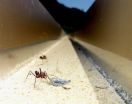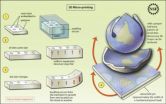Infection control certification associated with lower MRSA infection rates
2012-03-12
(Press-News.org) Washington, DC, March 9, 2012 -- Hospitals whose infection prevention and control programs are led by a director who is board certified in infection prevention and control have significantly lower rates of methicillin-resistant Staphylococcus aureus (MRSA) bloodstream infections (BSI) than those that are not led by a certified professional, according to a new study published in the March issue of the American Journal of Infection Control, the official publication of APIC - the Association for Professionals in Infection Control and Epidemiology.
A team of researchers from the Columbia University School of Nursing surveyed infection prevention and control departments of 203 acute care hospitals in California to determine if there is an association between structure and practices of their programs, and frequency of infections caused by antibiotic-resistant bacteria. MRSA bloodstream infection data for 91 of these hospitals were analyzed to see if there were factors that were associated with frequency of this infection. Presence of a board certified director and participation in a multifacility performance improvement project were associated with significantly lower MRSA BSI rates. This is one of the first studies that found an association between specific infrastructure elements, patient care practices, and rates of healthcare-associated infections. MRSA is a type of staph bacteria that is resistant to certain antibiotics and can cause serious infections.
Ninety-seven percent of hospitals in the survey reported some type of screening policy for multidrug-resistant organisms – primarily MRSA – upon patient admission, with the most commonly targeted populations being transfers from nursing homes (77.8%), readmissions within 30 days (75.6%), ICU patients (72.8%), and dialysis patients (63.3%). By contrast, few hospitals reported the use of universal and targeted screening for two other multidrug-resistant organisms: vancomycin-resistant Enterococcus (VRE) and Clostridium difficile (C. difficile). One major reason for this focus on MRSA is legislative requirements in California for these screening programs, but the authors contend that this level of specification on one type of pathogen may limit the ability to address others like VRE and C. difficile.
"The association between a board certified professional and fewer MRSA infections likely reflects greater awareness and level of implementation of evidence-based prevention practices," said APIC 2012 President Michelle Farber, RN, CIC. "This study also adds to an increasing amount of evidence that broad collaborative projects are an effective mechanism to improve performance and patient safety. In addition, the new study is timely as APIC has developed a new competency model for infection preventionists that emphasizes the value of certification. This new data reinforces the value of this credential for enhancing patient safety."
INFORMATION:
The Certification in Infection Prevention and Control (CIC®) credential, administered by the Certification Board of Infection Control and Epidemiology, Inc. (CBIC), identifies healthcare professionals who have shown a mastery of knowledge in infection prevention.
END
ELSE PRESS RELEASES FROM THIS DATE:
2012-03-12
Desert ants have adapted to a life in a barren environment which only provides very few landmarks for orientation. Apart from visual cues and odors the ants use the polarized sunlight as a compass and count their steps in order to return safely to their home after searching for food. In experiments with ants of the genus Cataglyphis in their natural habitats in Tunisia and Turkey, behavioral scientists of the Max Planck Institute for Chemical Ecology in Jena, Germany, have now discovered that ants can also use magnetic and vibrational landmarks in order to find their way ...
2012-03-12
Christian Santangelo, Ryan Hayward and colleagues at the University of Massachusetts Amherst recently employed photographic techniques and polymer science to develop a new technique for printing two-dimensional sheets of polymers that can fold into three-dimensional shapes when water is added. The technique may lead to wide ranging practical applications from medicine to robotics
The journal Science publishes the research in its March 9 issue.
Researchers used a photomask and ultraviolet (UV) light to "print" a pattern onto a sheet of polymers, a technique called photolithography. ...
2012-03-12
Researchers have identified a genetic signature for a severe, often painful food allergy – eosinophilic esophagitis – that could lead to improved diagnosis and treatment for children unable to eat a wide variety of foods.
The scientists, from Cincinnati Children's Hospital Medical Center, report in the Journal of Allergy and Clinical Immunology that they have pinpointed a dysregulated microRNA signature for eosinophilic esophagitis (EoE), a disease that also may cause weight loss, vomiting, heartburn and swallowing difficulties.
Interestingly, the dysregulated microRNA ...
2012-03-12
The faster a clock ticks, the more precise it can be. Due to the fact that lightwaves vibrate faster than microwaves, optical clocks can be more precise than the caesium atomic clocks which presently determine time. The Physikalisch-Technische Bundesanstalt (PTB) is even working on several of such optical clocks simultaneously. The model with one single ytterbium ion caught in an ion trap is now experiencing another increase in accuracy. At PTB, scientists have succeeded in exciting a quantum-mechanically strongly "forbidden" transition of this ion and – in particular – ...
2012-03-12
The detailed feather pattern and color of Microraptor--a pigeon-sized, four-winged dinosaur that lived about 120 million years ago--had a glossy iridescent sheen.
Its tail was narrow and adorned with a pair of streamer feathers, suggesting the importance of display in the early evolution of feathers, say scientists reporting the findings in this week's issue of the journal Science.
By comparing the patterns of pigment-containing organelles from a Microraptor fossil to those in modern birds, the scientists determined that the dinosaur's plumage was iridescent with a ...
2012-03-12
NOHO Dental Group and Dr. Afar, North Hollywood dentist, are offering a variety of specials for new and existing patients. For a short time, patients can receive discounts on a wide number of dental procedures, allowing both new patients and those who have been with the NOHO Dental Group for years to save money and try new dental services.
These specials include a wide variety of services, such as a $49 dental exam with x-rays for new patients. For patients who need preventative care like dental cleanings, this special allows new patients to try out the services of Dr. ...
2012-03-12
Infants and toddlers who have been treated for cancer tend to reach certain developmental milestones later than do their healthy peers, say researchers at the National Institutes of Health and in Italy.
The findings show that delays may occur early in the course of treatment and suggest that young children with cancer might benefit from such early interventions as physical or language therapy.
Compared to children who had not had cancer, children treated for cancer before age 4 progressed more slowly in vocabulary, cognitive functions such as attention and memory, and ...
2012-03-12
Amsterdam, NL, 9 March 2012 – The number of people with neurological and psychiatric disorders in Spanish-speaking countries has increased over the past two decades. The February issue of NeuroRehabilitation assesses important factors that should be considered in rehabilitating Spanish-speaking individuals suffering from these disorders.
"Though much work has been done in this area for Anglo-Saxon populations, very little work has focused on Spanish-speaking individuals," says Guest Editor Juan Carlos Arango-Lasprilla, PhD, of the Department of Physical Medicine and ...
2012-03-12
How do we recognize a face? To date, most research has answered "holistically": We look at all the features—eyes, nose, mouth—simultaneously and, perceiving the relationships among them, gain an advantage over taking in each feature individually. Now a new study overturns this theory. The researchers—Jason M. Gold and Patrick J. Mundy of the Indiana University and Bosco S. Tjan of the University of California Los Angeles—found that people's performance in recognizing a whole face is no better than their performance with each individual feature shown alone. "Surprisingly, ...
2012-03-12
An international team of physicists has determined a key parameter, which governs how neutrinos behave. This discovery measures a critical linchpin in the study of the tiny particles and in advancing the understanding of how these building blocks of all things, from galaxies to tea cups, came to be.
The Daya Bay Reactor Neutrino Experiment, a multinational collaboration including a team from Virginia Tech, discovered a new type of neutrino oscillation in which the particles appear to vanish as they travel. The researchers found that the rate of oscillations was much larger ...
LAST 30 PRESS RELEASES:
[Press-News.org] Infection control certification associated with lower MRSA infection rates





